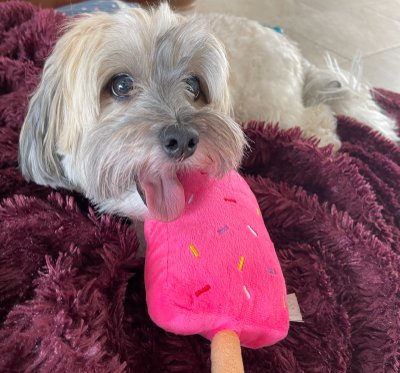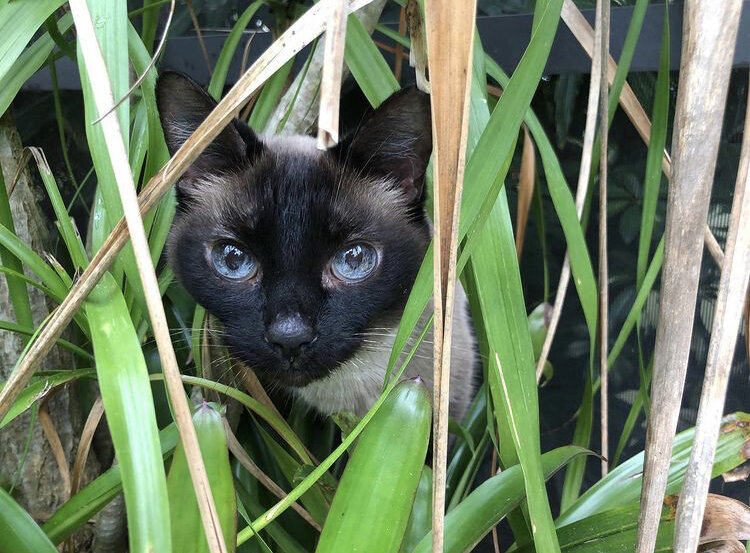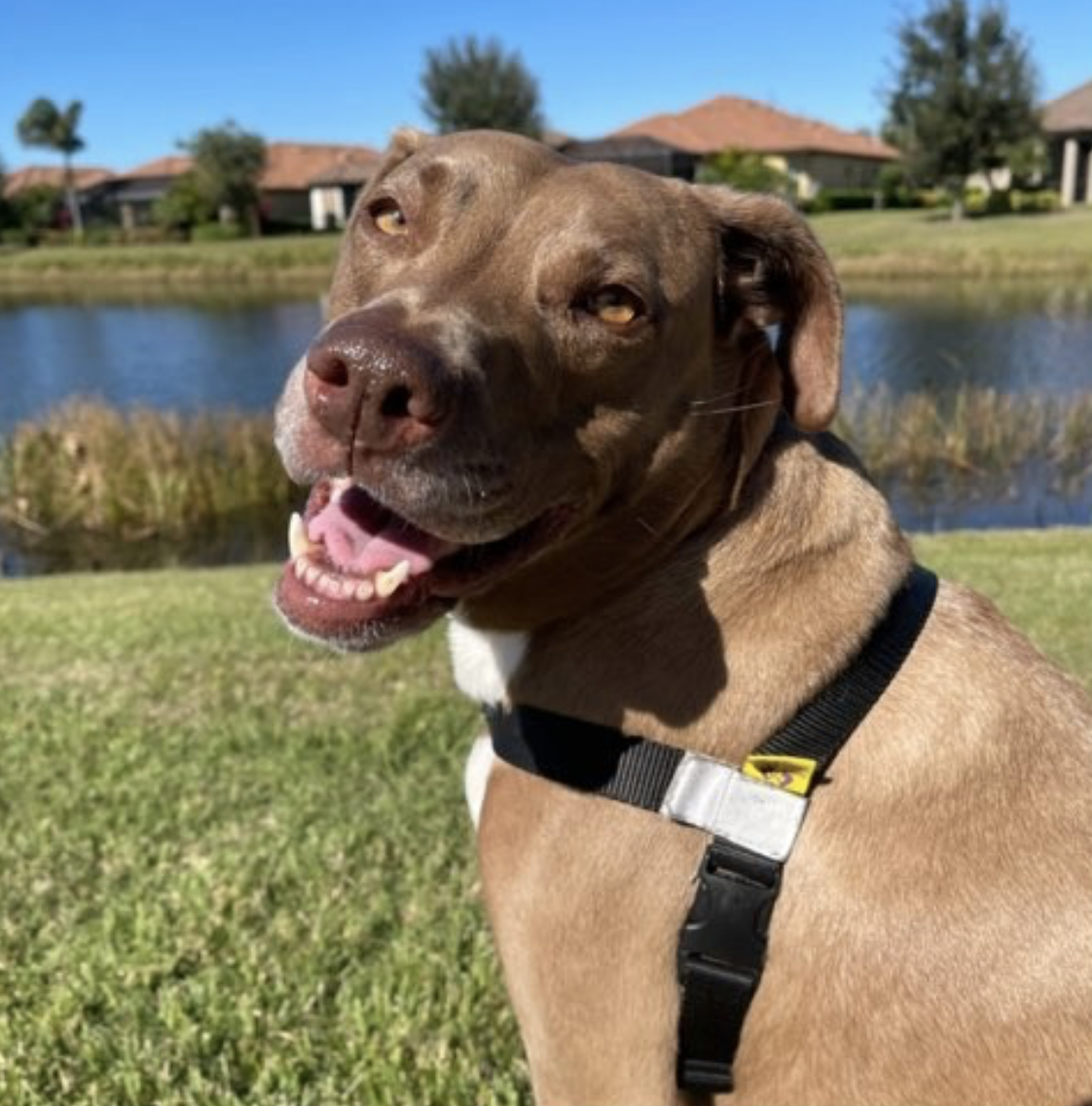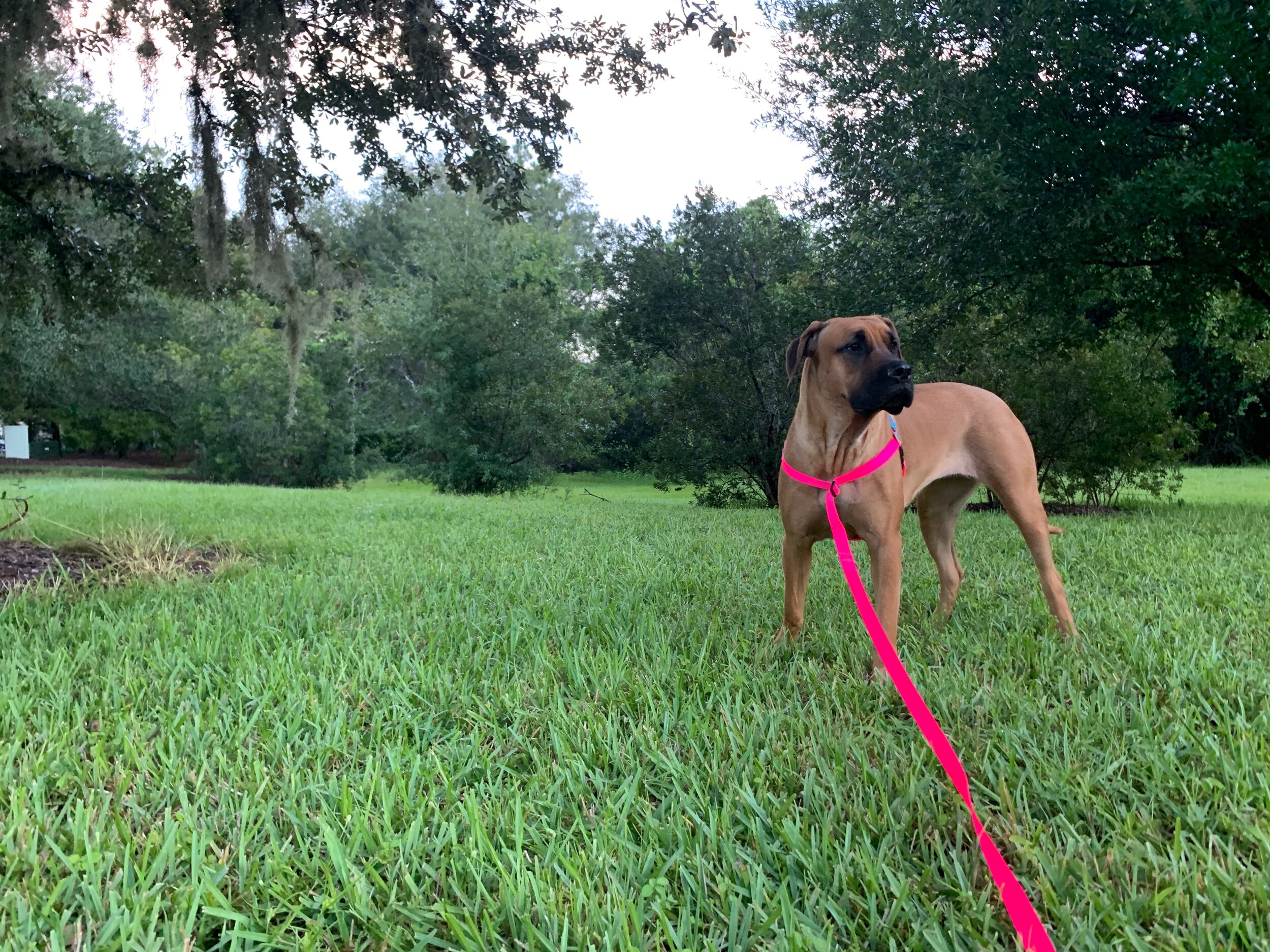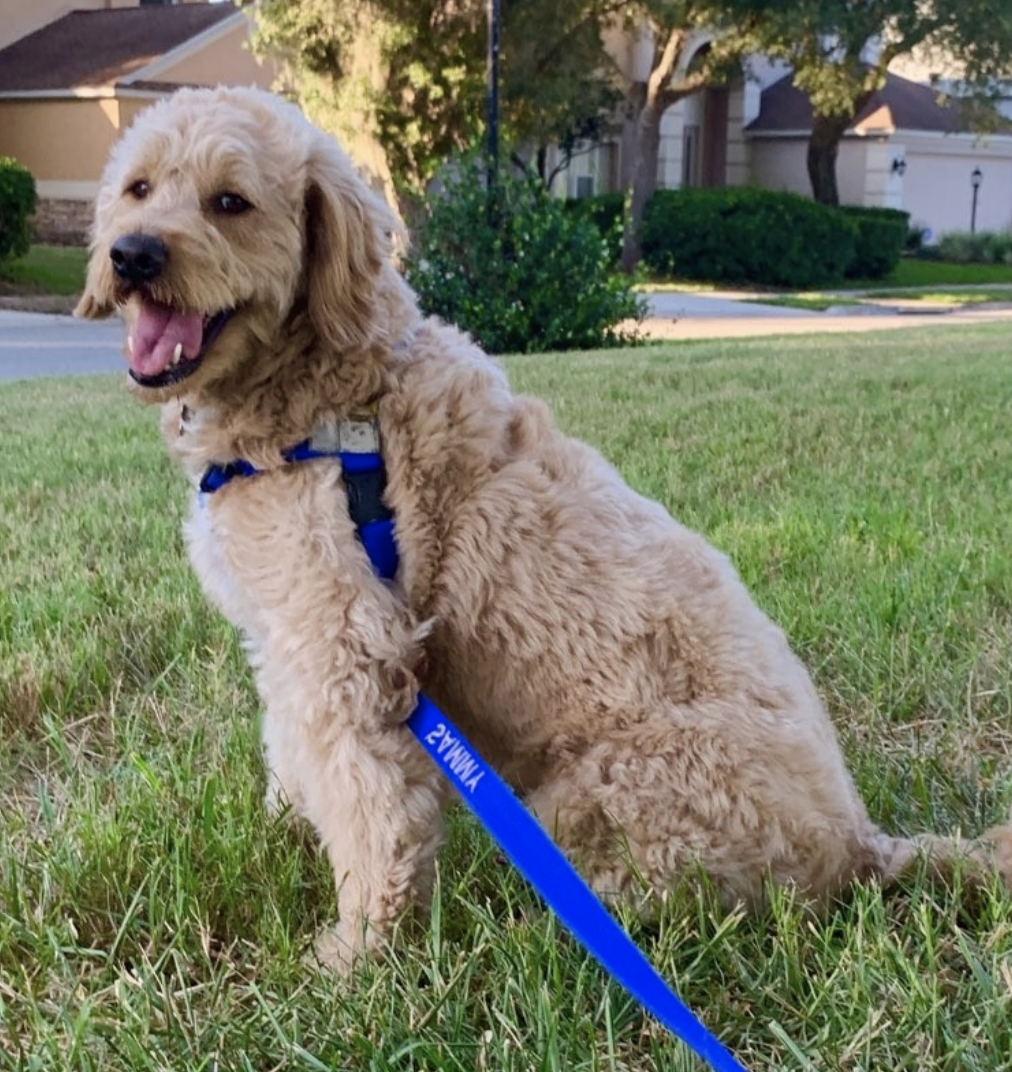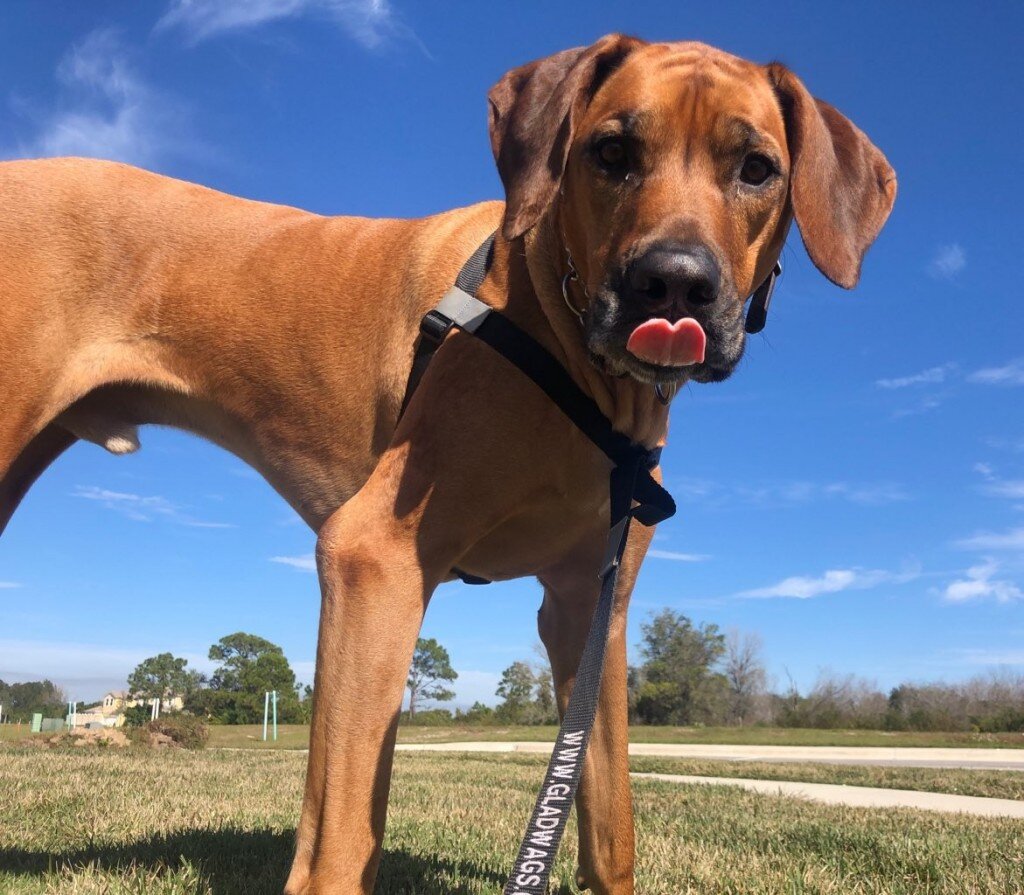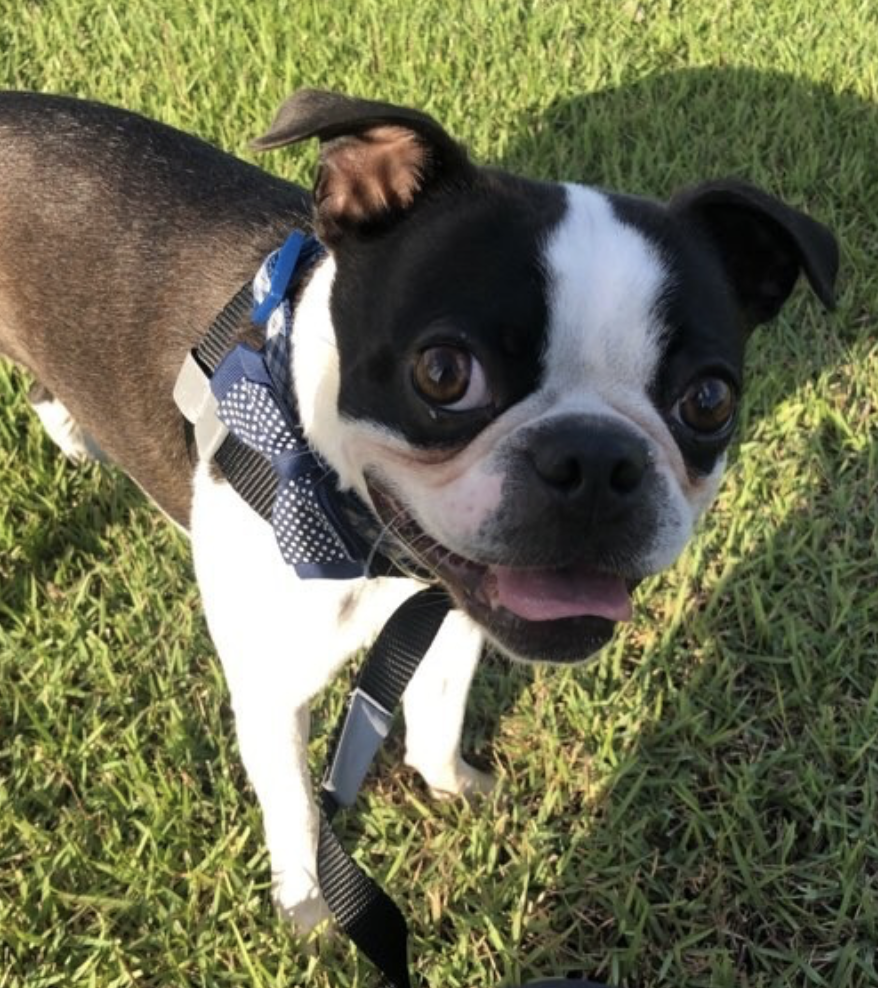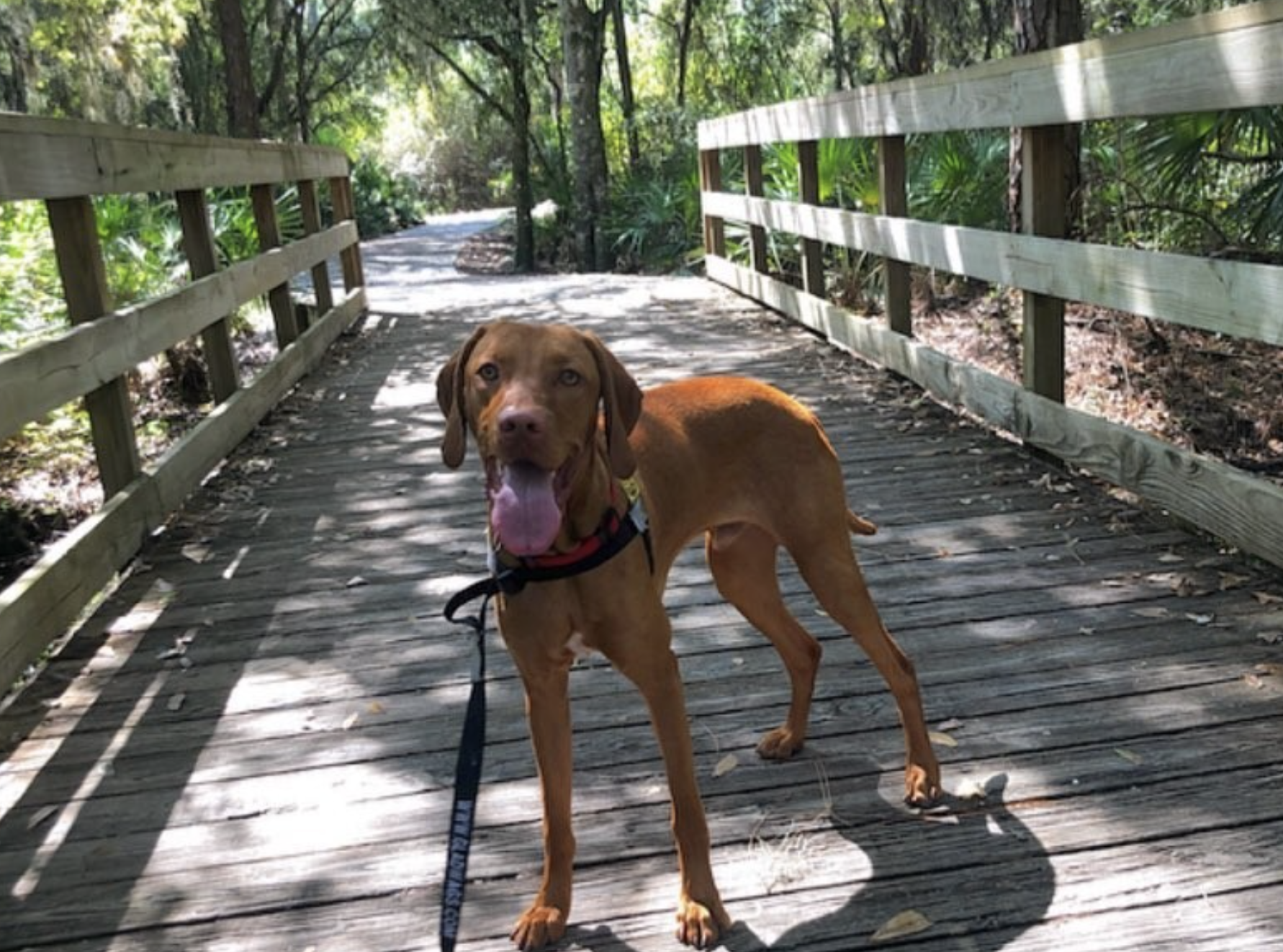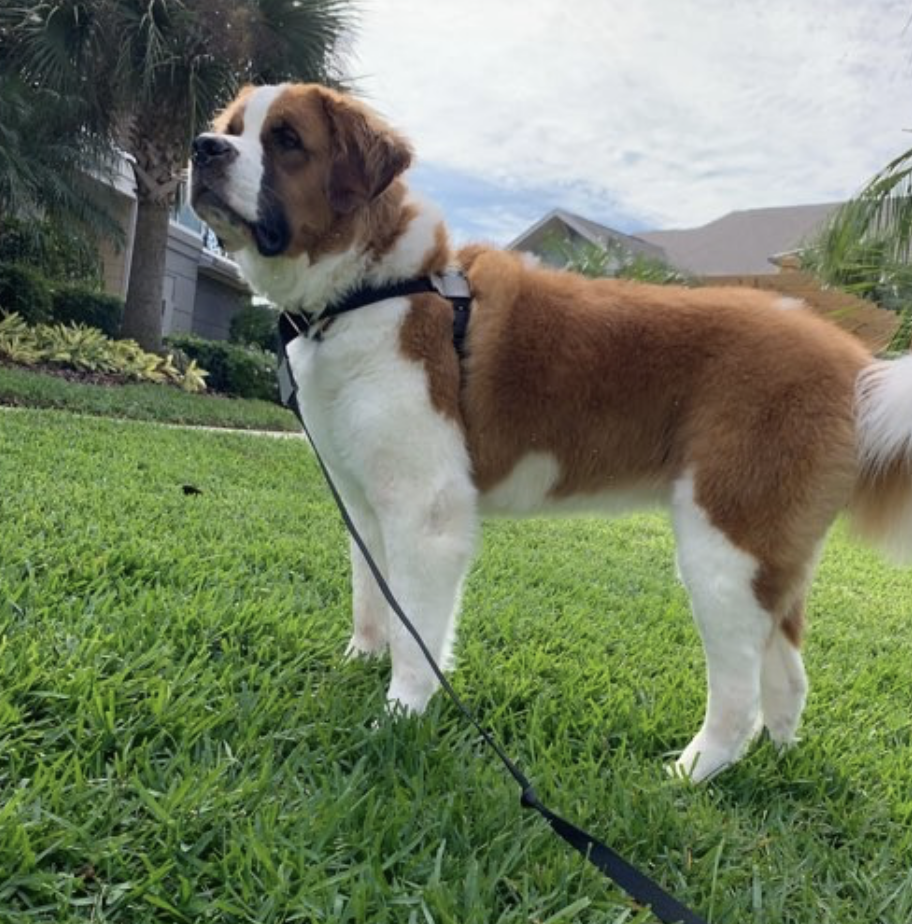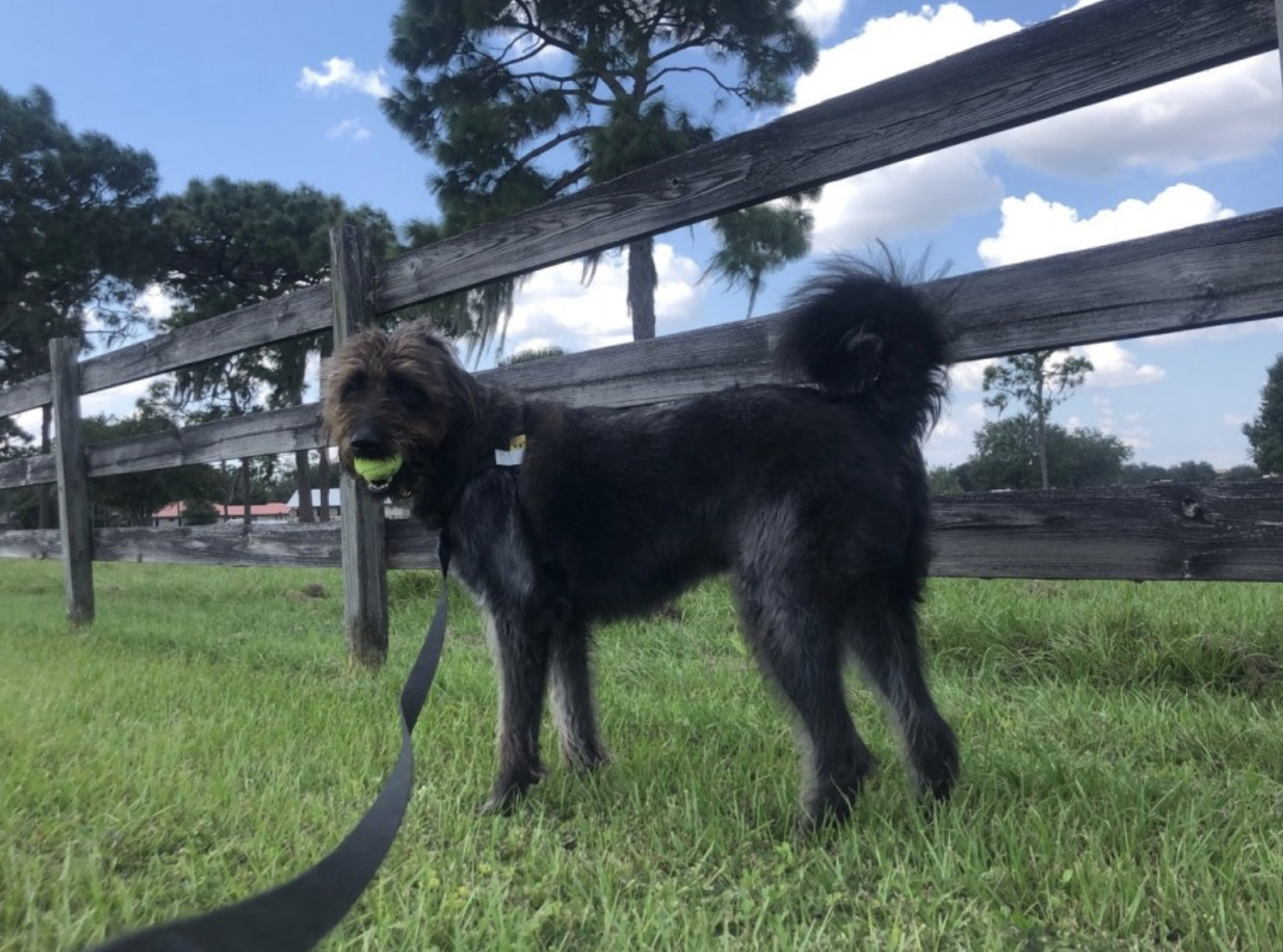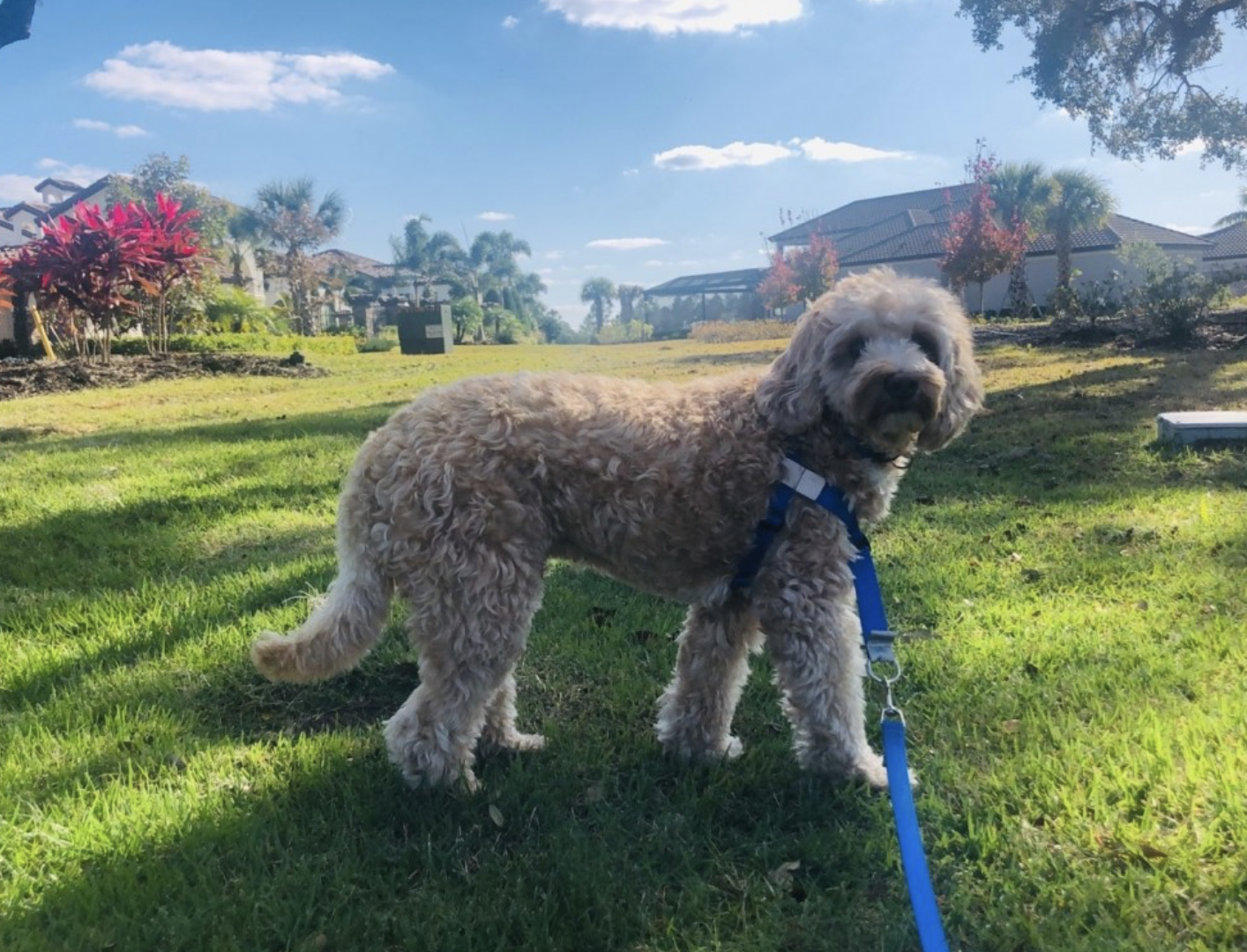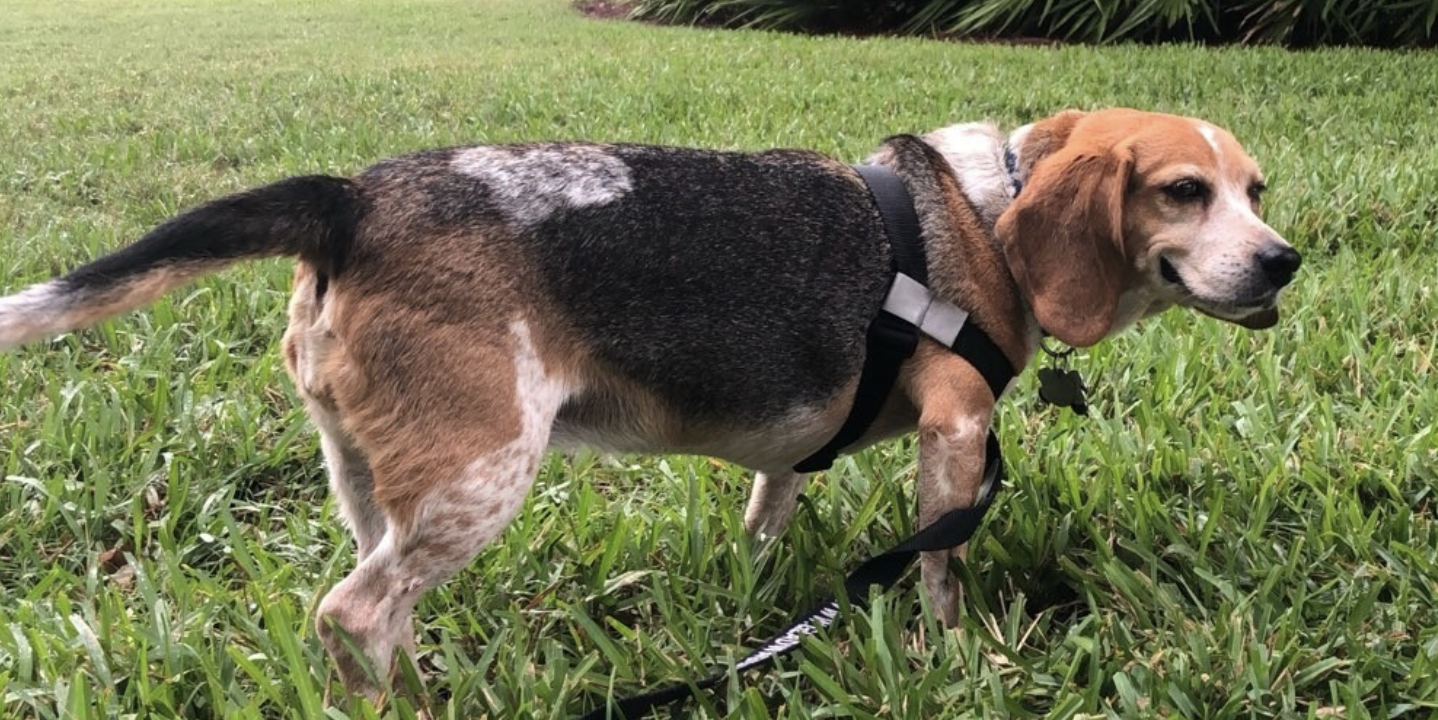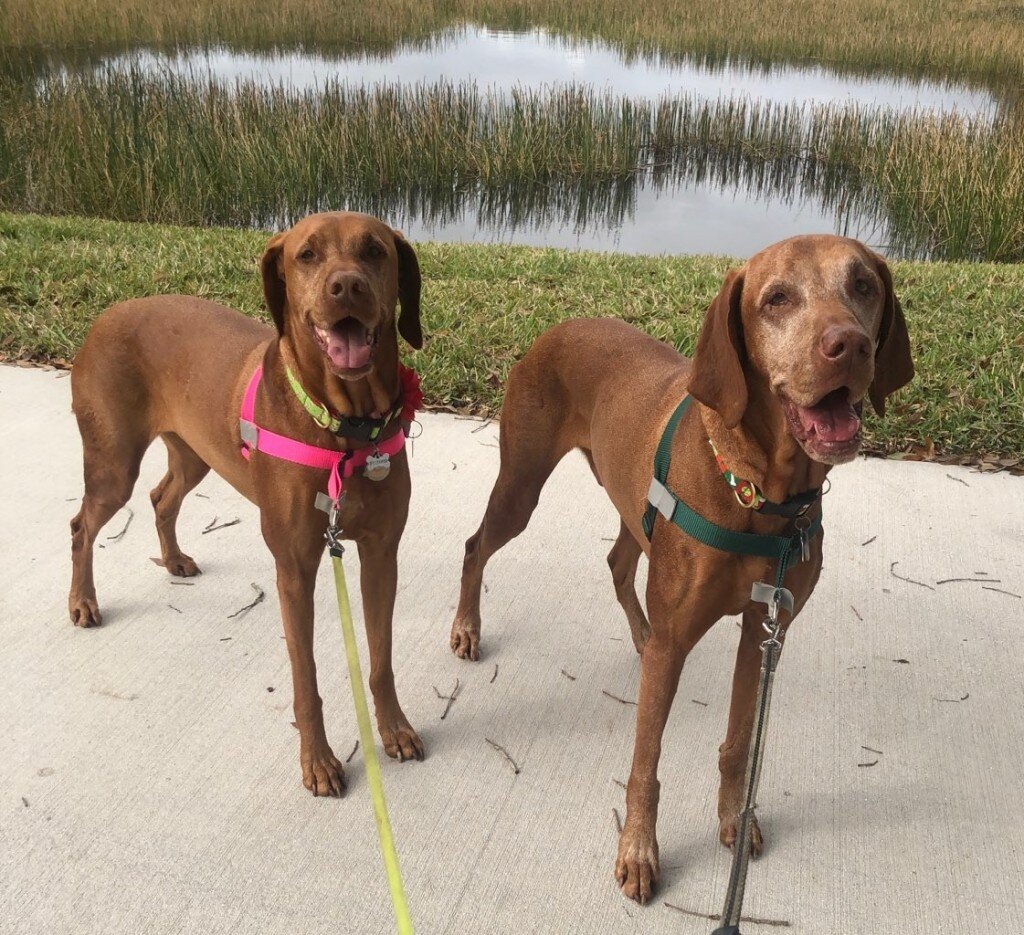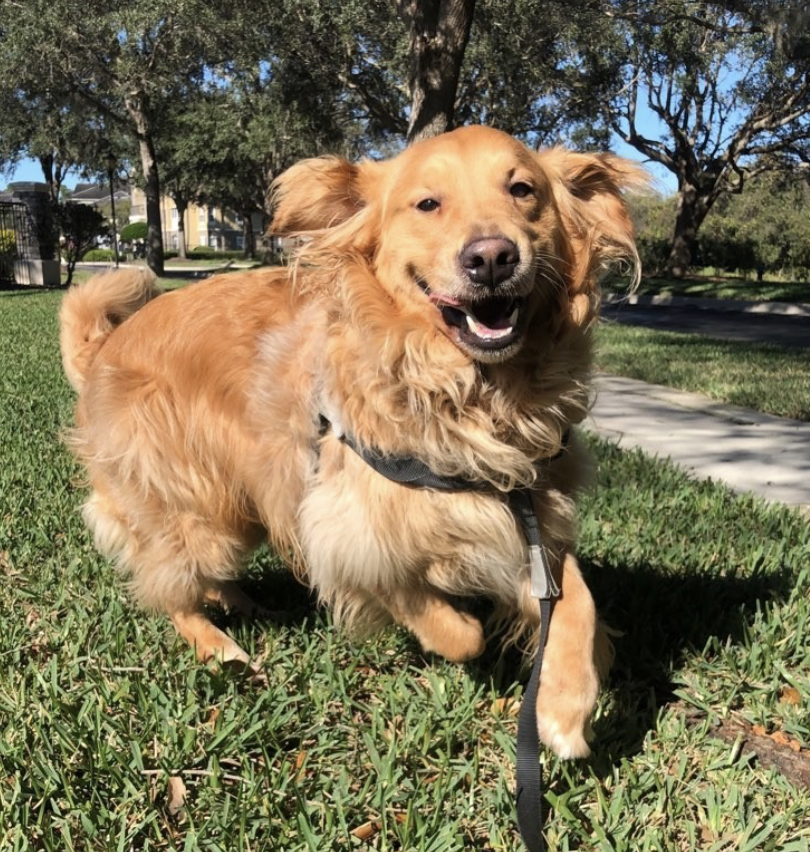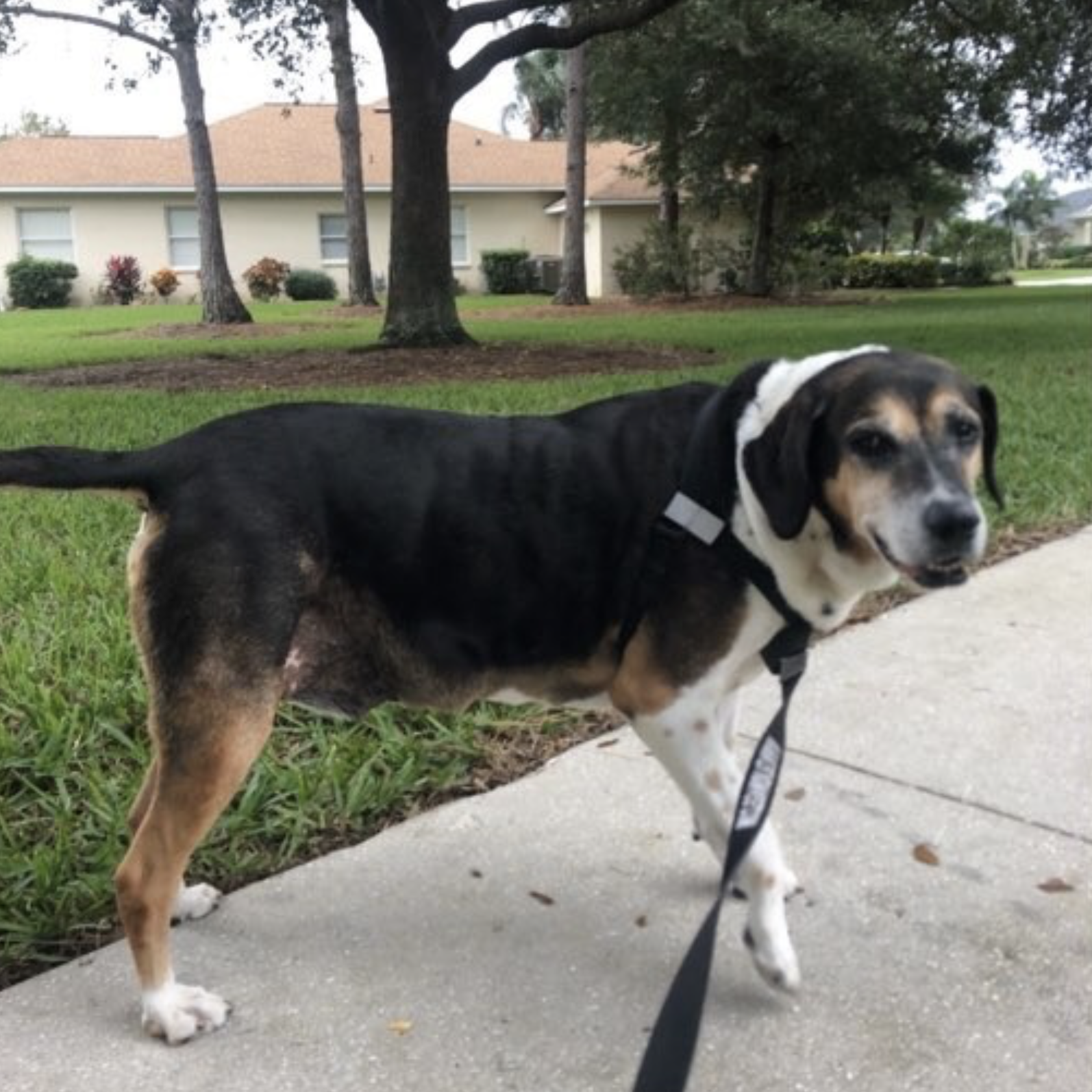5 Things To Do When Your Dog Won’t Potty Outside In Bad Weather
Dealing with a dog that refuses to potty in the rain can be frustrating, but with the right strategies, it’s possible to make it easier for you and your pup. In this blog, we’ll share five helpful tips for getting your dog comfortable outside in the rain.
Look for a covered area to potty
Looking for a covered area, such as a large tree or large umbrella, for your dog to potty during bad weather can provide a sense of security and comfort. A sheltered spot can encourage your dog to go outside when they might otherwise hesitate, ensuring they get the bathroom break they need.
Wear rain gear
Wearing rain gear like a raincoat and booties can make potty time more comfortable for you and your dog during bad weather. The raincoat keeps your dog dry and warm, while the booties protect their paws from getting cold or wet, preventing discomfort or irritation. This can make them more willing to go outside and do their business, as it reduces the negative impact of the weather on their experience. Plus, it helps keep them clean and dry when they return inside.
Get your dog used to the rain
To slowly start taking your dog outside in the rain, expose them to light rain for short periods. Use positive reinforcement like treats and praise when they go outside, even if they just stand there. Gradually increase the time spent outside and the intensity of the rain as they become more comfortable.
Try pee pads
If your dog refuses to go outside in the rain, you can try using pee pads as a temporary solution. Set up a designated potty area with a pee pad in a quiet, easy-to-access spot inside. Encourage your dog to use the pad by guiding them over it and offering praise or treats when they go. Over time, they may learn to associate the pad with potty time, especially during bad weather.
Bring their favorite toy
Bringing your pup's favorite toy outside during potty time in the rain can help distract them from the discomfort of the wet weather and make the experience more enjoyable. The toy can serve as a positive reinforcement, offering something familiar and fun to focus on while they do their business.
Every pup is different, so be patient and try different strategies to see what works best for your furry friend. After all, April showers bring May flowers!
https://pethelpful.com/dogs/dog-refusing-to-go-potty-in-the-rain
https://goodbuddydogtraining.com/my-dog-wont-go-pee-in-the-rain/
How To Dog Proof Your Home While You're Away
Whether your dog is a puppy, a newly adopted pup, or a dog that’s been part of the family for years, be sure to add, “dog proof the house” to your to-do list before you’re off on your next vacation. Doing so can save you money on household damages or even more importantly, a trip to the vet when you buddy “got into something. No worries, we’ve got you covered!
Whether your dog is a puppy, a newly adopted pup, or a dog that’s been part of the family for years, be sure to add, “dog proof the house” to your to-do list before you’re off on your next vacation. Doing so can save you money on household damages or even more importantly, a trip to the vet when you buddy “got into something.
No worries, we’ve got you covered:
Sweet pup anxiously awaiting his treat from his Glad Wags’ sitter.
Nom-noms: Stash away all food, including their own, so they aren’t tempted to counter-surf. Pay close attention to hiding away toxic foods such as chocolate, avocados, grapes, raisins, macadamia nuts, onions, and garlic. For a more complete list of toxic foods, visit the ASPCA website by clicking here .
PRO TIP: If you are the parent to an expert counter-surfer, consider putting foil on your countertops. Once Buddy places his paws on the loud material he will be less inclined to continue. You might also try lining your countertop with double-stick tape. Pups don’t like the sticky tape and are likely to stay away.
Get to the point: Securely put away anything sharp that your little rascal may snatch up such as knives, scissors, razors, blades from a blender or food processor, box cutters, and pins.
Sweat the small stuff: Twist ties, bread clips, rubber bands, batteries, buttons, hair-ties, jewelry, thread, crafts, or anything tiny can be enticing to a doggo who is left unattended. Although these things seem harmless, they can get lodged in your pup’s throat or digestive tract.
Lakewood Ranch is full of beauty, even on the side of a neighbor’s recycling bin!
A load of rubbish: Secure your trash cans! Take the trash out before you leave or figure out a way to keep Buddy’s nose out of the trash’s business. Some common solutions are putting it in a pantry/cabinet or placing a gate around it.
PRO TIP: Don’t forget about the small trash bins in bathrooms and offices; these can be even more dangerous because they don’t often have a lid and can contain dangerous items such as floss or old razors!
Down to the wire: Cords, wires, and chargers are popular items for pups to chew on and can be very dangerous as they can electrocute and burn your fur-friend. If possible, unplug any devices that your pup will have access to. Consider tucking the cords under cord concealers or completely removing the items from the room. It may be a time consuming task but this is a very important one!
PRO TIP: If you think your pup will mess with the outlets, try using outlet covers.
Comfy cozy: Pups can look at blankets, rugs, and fabric armrest coverings as big toys. If you think Buddy will go after the couch cushions and pillows, block off couches with dining chairs or limit their access to rooms with these pieces.
Dapper boy is always stylin’ in one of his bow-ties!
Best dressed: Depending on what type of packer you are, you might leave your clothes spread out on the floor or leave behind a pile of dirty laundry in your hamper. We won’t add “do laundry” to your to-do-list but at least put all your clothing out of reach from your pup, particularly dirty laundry. They enjoy working on (aka chewing on) buttons, strings, and zippers, stinky socks, and the all-time favorite….shoes! Save your clothes, shoes, and your dog’s intestines and stow these types of things far from reach.
Pick your poison: Our homes are filled with toxic hazards such as cleaners, detergents, bleach, moth balls, pesticides, medications, cosmetics, perfumes, and toiletries. Keep these types of items far, far away from your solo pup. Put them in a closet they do not have access to or a high cabinet that has some type of lock on it. Check out these child-proof cabinet locks that can also be used for nosey noses snooping around.
Fast friends: If you have small critters in the house, such as fish or hamsters, think about moving them to a new location if you aren’t sure how your pup might do alone with them.
Having a snooze after her outside time.
Beauty sleep: Some owners like leaving their bedroom open for access during their time away because Buddy likes having a snooze on their bed. Some canines love to tear up anything soft (uh, have you seen what they can do to a stuffie toy) so not granting them access to your bedroom would be ideal. But, if you are still adamant about having them keep your bunk warm, remove your pillows, quilts, comforters, sheets to spare them from becoming the next casualty!
Potty mouth: Shut your toilet lids! Although your pup doesn't care about manners, the latrine lid should stay closed. The chemicals used to clean the toilet can make a thirsty pup very sick. Tiny pups could even drown in the bowl! If your headstrong bud knows how to lift the seat, try one of these nifty devices.
PRO TIP: As gross as it is, Buddy might raid the cat’s litter box. If this is on your dog’s favorite foods list, find a home for the box that Buddy can’t get to.
Blind spot: Vertical blinds, particularly ones made of fabric, sway side to side and can become quite a tempting toy! Block these strips with chairs if possible.
Playtime with one of his favorite toys!
Toy story: Leaving Buddy’s toys out is very important but if your pup is likely to rip up their toys (which is fine) first remove any squeakers, strings, and stuffing, if you believe your pup will consume it after it’s ripped up.
Reality TV: Hide your remotes!! You’ll thank us.
Pretty as a picture: Figurines, vases, and any decor that is within reach (even as high as your dog can reach on his hind legs) should find a new home while you’re away.
Arts & crafts: Have you ever seen what a pup can do with newspapers, magazines, books, cash money, paper towels, napkins, or toilet paper? They can create homemade confetti in seconds flat! Double check that you put away all these tempting paper products.
Fresh Air: Air fresheners & candles are a big “no-no” for pets when home alone. Your pup is more important than a nice smelling house.
Handsome Havanese posing during a Glad Wags’ walk.
Green thumb: Many pet owners are the parents to indoor house plants too but you will be disappointed to find your plants dug up and even consumed. Move these plants to an off-limits room, even succulents are fair game to Buddy! Non-toxic plants can still cause lesions in the digestive tract. For a full list of toxic plants, check out our Toxic Plants and Flowers To Avoid For Dogs And Cats blog.
Off limits: If doggie proofing your home is still not enough to save your stuff, try limiting the space in which your dog is allowed to roam. Close doors and only allow access to the main living area. If you need to limit space even further, put your pup in a large penned area of the house.
PRO TIP: Remember that a tired dog is a good dog so be sure to use a sitter who can tire your dog out physically and mentally.
Toxic Plants and Flowers To Avoid For Dogs And Cats
As a pet parent, it’s very important to be knowledgeable about which plants and flowers could be dangerous to your puppy pals and feline friends. Below is a list of the most common toxic plants that are dangerous for pets to consume.
Please note, this is not a complete list of all poisonous plants.
As a pet parent, it’s very important to be knowledgeable about which plants and flowers could be dangerous to your puppy pals and feline friends. Below is a list of the most common toxic plants that are dangerous for pets to consume.
Please note, this is not a complete list of all poisonous plants.
Adam-and-Eve
Aloe
Amaryllis
Andromeda
Apple
Apricot
Arrow-Head Vine
Arum
Arum Lily
Australian Nut
Autumn Crocus
Azalea
Barbados
Basil
Bay Laurel
Bead Tree
Begonia
Bird of Paradise
Bittersweets
Brazilwood
Boxwood
Brunfelsia
Buckeye
Buckwheat
Buddhist Pine
Burning Bush
Buttercup
Calla Lily
Caladium
Cape Jasmine
Cardinal Flower
Carnation
Castor Bean
Ceriman
Chamomile
Cherry
Chinaberry
Chives
Chrysanthemum
Cilantro
Clematis
Coffee
Coontie Palm
Creeping Charlie
Cycads
Cyclamen
Daffodil
Daisy
Dieffenbachia
Dracaena
Dumbcane
Easter Rose
Eastern Star
Elephant Ears
Epazote
Eucalyptus
Exotica
Fern Palm
Fig
Figwort
Flag
Flamingo Flower
Foxglove
Gardenia
Garlic
Geranium
Gladiola
Grapefruit
Heavenly Bamboo
Holly
Hops
Horse Chestnut
Horseweed
Hosta
Hyacinth
Hydrangea
Indian Hemp
Iris
Ivy
Jack-in-the-Pulpit
Jonquil
Kalanchoe
Kiss-me-Quick
Klamath Weed
Lambkill
Lantana
Larkspur
Laurels
Lavender
Leek
Lemon
Lemon Grass
Lenten Rose
Lillies
Lime
Lobelia
Maidens Breath
Marijuana
Milkweed
Mint
Mistletoe
Morning Glory
Mother-in-Law
Mum
Nandina
Narcissus
Nightshade
Oleander
Onion
Orange
Oregano
Parsley
Peach
Peony
Perennial Pea
Periwinkle
Pieris
Plum
Poinsettia
Poison Daisy
Poison Hemlock
Poison Parsnip
Portulaca
Prayer Bean
Primrose
Privet
Purslane
Ragwort
Ranger's Button
Red Emerald
Red Maple
Rhododendron
Rhubarb
Ribbon Plant
Rock Moss
Rosebay
Running Myrtle
Sabi Star
Sago Palm
Silver Dollar
Snake Lily
Sorrel
SowBread
Spanish Thyme
Spindle Tree
Spring Parsley
Staggerbush
Starch Root
Starleaf
Sweet Pea
Taro
Tobacco
Tomato
Tulip
Weeping Fig
White Heads
Wild Arum
Winterberry
Wisteria
Yarrow
Yew
Yucca
ASPCA Animal Poison Control Center Phone Number: 888-426-4435
What To Do When Your Dog Jumps On You
Knowing how to react to your dog jumping on you is super important because our initial response tends to be the incorrect one. Whether you are the owner of a jumping pup or you have a friend who is trying to break their pooch of a hopping habit, it’s important to know how to react when the pup turns into a jumping bean.
Family of four with all four paws on the floor, waiting patiently for attention
Knowing how to react to your dog jumping on you is super important because our initial response tends to be the incorrect one. Whether you are the owner of a jumping pup or you have a friend who is trying to break their pooch of a hopping habit, it’s important to know how to react when the pup turns into a jumping bean.
Why do dogs jump in the first place? The main reason unwanted jumping occurs is simple: human attention. At some point in your pup’s life, they jumped on a human to catch their attention, and guess what, it worked! They get the attention in many ways, pets, ear scratches, all the things they love the most. So naturally, the dog made the association.
Dog thought: “Jump on human = get attention. I’m always going to jump on humans because I LOVE attention!”
Small, medium, or large, all sizes can learn to keep their paws to themselves
Then as the puppy gets bigger, it is deemed unwanted behavior by the owner, but the dog thinks everything is just fine the way it is because he still receives the attention he’s seeking.
Read on for tips on fixing this problem behavior.
IGNORE
Sweet sibling pups demonstrating “all-four-on-the-floor”
The best thing you can do while a pup is jumping on you is to completely ignore them! As cute as they are when looking up at you, you must resist the urge to pet and talk or give any type of positive attention to them until they have “all-four-on-the-floor”! Do not touch them, talk to them, or even look at them. Stand still, arms folded, staring in the distance. Essentially, become boring. Your calm and quiet energy is vital. If your pup jumps on you while you are sitting, stand up and ignore them.
IMPORTANT! Avoid giving them negative attention, too. A pup, much like some humans, value any type of attention. If you are reprimanding or pushing them off, the result is the same - they got your attention and will continue the behavior.
THE COLD SHOULDER
This rottie gal is the queen of the polite sit
If standing silently without eye contact and interaction is still not working, turn your back to them. A quiet, still, disengaged human is very boring to a dog (insert big dog yawwwwn) and they will eventually lose interest in you or at least calm down enough to stop jumping on you.
Let your guests know that you are training your dog and to please not give them any attention until they are calm. This is hard for humans to do because we’re thinking like a human and think it might be rude to ignore the dog, just as it’s rude to ignore a person, especially when you’re a guest. That’s why giving your guest permission to ignore your dog is so important.
RE-ENTER
In some cases, ignoring them and giving them the cold shoulder may not work if the dog has been conditioned to jump for attention. Take the training to the next level by completely leaving the room or the house when your pup pounces. If he jumps, go out the door. Then, re-enter. If he jumps again, leave through the door again. You might have to do this many, many times before he learns that he’ll receive no attention from anyone that comes through the door if he jumps on them. Consistency and patience will pay off!
GIVE ATTENTION
Not only is it important to know when not to give attention, it is equally important to know when to reward your pup with attention. Once he has all four paws on the floor, preferably in a sit, you can and should give attention immediately to reinforce the wanted behavior. But, be prepared to go back to step 1 if they start to jump again.
Boston siblings showing off how well-mannered they are!
BE CONSISTENT
This type of training is only effective if the owner puts in consistent effort. Everyone in the household, including friends, family members, and even acquaintances and service providers, should be told by the owner the steps to take once your pup starts springing up like a pogo stick. Insist that your pals (and you) follow the protocol, which is to ignore the dog if they jump. Soon your pup won’t be tempted to give an airborne greeting, and you won’t be embarrassed by their behavior.
The Best Pet Care In The Industry
Choosing care for your pet is important and can become a stressful task once you start reviewing all the options that are available. Finding a person, company, or facility that possesses a love for animals is a given but what about the other aspects that makes up quality pet care. Let’s break it down!
Company Employee - Independent Contractor
Solo Sitter - App Sitter - Boarding Facility
Choosing the appropriate care for your pet is essential and can become a stressful undertaking once you start reviewing all of the options available. It’s a given that the pet sitter you choose should possess a love for animals, but there are many other important considerations when hiring a pet sitter.
PROFESSIONAL IN-HOME PET CARE BUSINESS (that hires “employees”) - The Gold Standard
Professional pet care businesses, like Glad Wags, are owned and operated by a certified professional pet sitter through Pet Sitter’s International (PSI). PSI is the world’s largest and most respected authority on pet sitting and the leading association for professional pet sitters. They provide their members with the most up-to-date, on-going education and resources. This knowledge translates to exceptional, 5-star care for your pet. Benefits to hiring a professional pet care business, include:
The ability to leave your pet in the comfort of their own home without interrupting their routine, and where they feel safest.
In-home care means that your pet is not exposed to potential viruses often found in boarding facilities, such as kennel cough or influenza, nor the possibility of injuries associated with a group setting while boarding.
This type of premium care also includes one-on-one companionship for your pet and the ability to tend to their unique needs, such as administering medications or preparing their special meal.
A pet sitting company’s team of sitters are insured, bonded, background-checked, trained by field management staff, and accountable to the company for each visit provided.
A team of sitters allows for pet care 365-days a year. If one sitter is on vacation, or ill, or has a personal emergency, other sitters on the team who know and love your pet are able to continue care without interruption. Back-ups are key in finding reliable pet care; something a solo sitter cannot provide.
Long-term relationships are built between the company’s owner, sitters, the client, and their pet that are built on communication, accessibility, reliability, and trust.
Pet owners will enjoy the convenience and efficiency of sophisticated technology that enables online scheduling, payments by credit card, text-like communication feeds, real-time visit reports with engaging, quality photos through a pet sitting software program and mobile app.
While you’re away, your home will never appear that you’re not home. We will collect mail/packages/newspapers, maintain trash, water plants, rotate lights, and keep your home secure.
EMPLOYEE -VS- INDEPENDENT CONTRACTOR
Hire a company with employees versus independent contractors. There is a major difference between companies that hire employees as pet sitters versus independent contractors as pet sitters. Namely, a business with employees is able to control the way their sitters perform their job, meaning the type of care they provide.
EMPLOYEES
Glad Wags hires employees only. We work closely together as a team when caring for all of our clients’ pets.
Lead sitter, Amanda, taking a play break with a wild pup.
We provide Workers Compensation to our employees in case of an injury on the job. This type of insurance cannot be provided to independent contractors, the contractor may elect to obtain it themselves, but most do not.
We contribute to social security, medicare, and unemployment.
We carry liability insurance and bonding.
We manage, train, coach, and mentor our employees for consistency of care. By law, this type of guidance cannot be provided to or required of independent contractors as they are essentially a hired 3rd party company.
Glad Wags field management is always available to our employee team for back up and emergency care should it be needed.
Pet sitting companies with employees show integrity. By law, a pet sitting company that contracts their pet sitting services is illegally misclassifying their workers as independent contractors when in fact they should be classified as employees, and the company is then required to contribute to social security, medicare, and unemployment taxes.
INDEPENDENT CONTRACTORS
An independent contractor hired by a pet sitting company essentially has their own pet care business. They are then hired to care for a pet sitting company’s clientele. Why is this an issue?:
Glad Wags sitter, Ann, giving love to a puppy client.
According to the IRS classification of independent contractors, they are not legally allowed to be trained or managed by a company hiring them. They can establish their own “standard”.
They are not required, by law, to follow the pet sitting company’s policies and procedures and are legally free to care for your pet however they please and whenever they please.
Contractors have little supervision and cannot be told how to handle your pet. They are not required to report to a visit at a certain time and can shorten or change visits that you have requested. They can even subcontract the visits and send another person into your house without notifying you or the company you hired!
BOARDING AT A KENNEL
When a pet owner considers going out of town, boarding at a kennel is a popular option they consider. At a kennel, pets are fed and housed (crated), looked after in a facility by various staff members that your pet does not know. Potential issues that arise from this type of care, include:
Parrot client calm and happy in his cozy home.
Various required vaccinations in order to stay at the facility. In-home care eliminates this requirement, owners can choose to vaccinate as they choose.
Even with vaccinations, an increased possibility that viruses and bacteria, such as kennel cough and influenza, may be transmitted to your pet.
There is an increased possibility that your pet will experience an injury due to exposure to many other dogs with free rein in an enclosed space with little supervision. Depending on the facility, there could be as many as 80-100 dogs with free rein on any given day, particularly during the holidays.
Increased anxiety for your pet is likely, and the possibility of a lifelong fear of other dogs is also possible due to exposure to so many dogs day after day. This is a particularly unpleasant environment for puppies and senior dogs.
The stress of a pet being away from their family, home, and daily routine often has a lasting effect.
Pet owners will be charged for “additional services” such as medication administration, a solo walk, late pick-up, and much more. In most facilities, you will even have to pay extra to have your dog petted.
Owners have the burden of transporting their pet and their supplies to and from the facility and are tied to the facility’s drop-off and pick-up times, as opposed to having their calm pet waiting for them at home when they return.
HOBBY SITTER/SOLO SITTER/FRIEND/NEIGHBOR
Known by many names, “hobby-sitter”, “solo-sitter”, “gig worker”, or even a friend or neighbor is a person who provides pet sitting services either in your house, or their home as a side job or for a little additional income. Although you might find comfort in choosing a person who you know well, there are many issues that arise when using this type of pet care, such as:
Senior client enjoying his walk through his neighborhood.
Likely that the sitter does not carry liability insurance, bonding or workman’s comp insurance.
The sitter may not be educated in pet care, and have little pet experience.
Sitters tend to have other jobs or obligations (i.e., husband, kids, parents), making your pet’s care not their top priority.
Sitter is often unavailable, especially for last-minute requests and holidays, because they are already booked with another pet or they are tied up with their own personal obligations, work schedule, or most likely they “don’t work holidays”.
In the event of a sitter emergency, injury, or illness, sitter does not have a back-up sitter to continue care for your pet if they are suddenly out-of-commission. This is particularly bad when you are out of town, or out of the country.
Sitters tend not to follow professional procedures, policies, and protocols that keep your pet healthy and safe and ensure the care that is being provided to them is exactly what you wanted.
Owner is unable to use professional pet sitting software, to schedule, communicate through a portal, and pay with a credit card if desired.
APP SITTERS
Perky Westies taking a post-walk rest on their favorite couch!
App companies such as Rover and Wag are well-known because of their marketing but they are not professional pet sitting companies. They are e-commerce websites where services are provided by multiple third parties (“Sitters”). These referral-type websites do not meet the actual “sitters”, they are independent contractors (not employees) and the App cannot control a standard of care. It is up to the pet owner to do due diligence for the safety and well-being of their pet and the security of their home, but sadly many do not.
The Best Dog Harness For Pullers
There are many dog products on the market and with endless options, it can become overwhelming when deciding on what to use to walk your dog, particularly if you have a pup that pulls. As dog walkers, we have experienced just about every product on the market and we are going to share with you our #1 pick, especially if you have a “puller”.
With so many dog walking products on the market, it can be overwhelming when deciding what to use to walk your dog, particularly if you have a pup that pulls. Glad Wags’ dog walkers have hands-on experience using just about every style on the market and we are going to share with you our #1 pick, especially if you have an extreme puller of any size or breed.
Parents of pullers should skip putting anything around their dog’s neck, such as a traditional clip collar, a prong collar, a martingale, or a slip lead. These types of collars are not effective for pullers. More importantly, when a collar of any kind is used on a dog that pulls, the pressure is put onto their throat and over time this may cause serious illnesses, such as a collapsed trachea. This is an irreversible injury and will leave your dog with a harsh, dry cough that will last the rest of their life. A collapsed trachea may also cause labored breathing, fainting, wheezing, and exercise intolerance. This does not make for a fun walk for your dog or the owner. This is why it is so important to have the correct equipment!
A harness is a good option for pullers, and popular amongst many pet parents. But the type of harness is critical. Using a harness where the leash attaches on the back is a mistake. With the hind legs and chest being the strongest part of a dog, attaching the leash to their back will give them endless, uninhibited pulling power. There is a reason sled dogs have their leashes attached to their backs!
So, which harness is the best? Choose a harness where the leash attaches at the chest. This will give you all the control you need to handle your pet during a walk.. no matter what their size or breed! Why? By having the leash attached at the chest it works similar to a horse rein. If the dog pulls forward to the end of the lead, they will automatically be slightly turned left or right depending on which side the leash is on, resulting in them slowing down or even stopping. Many clients have come to us to ask for help to control their extreme puller. We show them how they can walk their dog with one hand using the correct harness. They tell us that they can finally enjoy walking their dog again!
There are plenty of front attaching harnesses on the market, but the easiest to use, due to its simple design and lightweight construction, is the harness made by the company, Walk Your Dog With Love.
Walk Your Dog With Love carries seven different styles of harnesses, yet all of them are designed with simple straps, one clip, and the leash attachment is always at the chest. They offer a variety of colors, embroidery options, and sizes to fit a tiny chihuahua or a hefty St Bernard. Their website provides you with information on their products, how they work, and even contains a video on how to properly fit the harness to your dog. The correct size and fit is critical! It will not work effectively without a proper fit, so we encourage our clients to allow the Glad Wags team to fit the harness on their dog or watch the video provided on the Walk Your Dog With Love website before hitting the sidewalk for their first walk.
Check out the photos below of our happy doggy clients modeling their harnesses while on their walks.
Enjoy walking your dog again and keep them injury-free!
Top Items To Have In Your Pet First Aid Kit
Having a complete pet first aid kit is an important step to ensure the safety and well-being of your pet in case of a serious emergency or a simple cut or scrape. Be certain that your kit accompanies you and your pet on trips to the dog park, campgrounds, and family road trips so you always have the items readily available no matter where you may be. Always inform your pet sitters and family members where the kit(s) are stored. All items can be picked up in one trip to the drug store or ordered online as a complete kit.
Having a complete pet first aid kit is an important step to ensure the safety and well-being of your pet in case of a serious emergency or a simple cut or scrape. Be certain that your kit accompanies you and your pet on trips to the dog park, campgrounds, and family road trips so you always have the items readily available no matter where you may be. Always inform your pet sitters and family members where the kit is stored so they can be prepared to care for your pet should an emergency arise.
All of the following items can be picked up in one trip to the drug store or ordered online as a complete kit:
Important Phone Numbers
Add the following numbers to your phone’s contacts and write them on an index card that can be stored in your kit:
ASPCA Poison Control Center: 888-426-4435
Your Veterinarian include address and phone number
Local 24/7 Emergency Pet Hospitals
Pet Identification & Vaccination Record
Quick access to these important records are essential should your pet need to be seen by emergency pet hospital personnel or should you need to refer to them when calling poison control.
Pet First Aid Guide
A quick reference guide with specific directions on how to properly use the items in your kit.
Medications
Consult your vet about proper doses of medications for your pet and write them on each box.
Aspirin Tablets
Benadryl
Anti-diarrheal (Loperamide)
Anti-Nausea/Motion Sickness (may need to get from vet)
Burn Gel (with Lidocaine)
Neosporin
Antiseptic Wipes
Betadine Antiseptic Solution
Sting Relief Pads (Benzocaine)
Hydrogen Peroxide (helps induce vomiting if pet ingested something poisonous)
Eye Wash
Eye wash can help alleviate irritation and flush away dirt and debris.
Ear Wash
Ear wash flushes debris trapped within the canal that may lead to infection if not removed.
Tweezers
Tweezers are handy for removing splinters, burrs, ticks, and other hard to grasp irritants that may attach to your pet’s skin.
Tongue Depressor
These are a great tool to use when examining your pet’s mouth.
Digital Thermometer & Lubricant
The most reliable way to obtain your pet’s temperature is rectally, which is why lubricant is important for the comfort of your pet. Note that dogs and cats have a temperature range that is higher than humans. Normal body temperature for dogs is 101-102.5 and for cats 100.4-102.5 degrees Fahrenheit.
Instant Cold Packs
Certain injuries require cold compresses to help reduce inflammation and relieve pain, such as bee stings, sprains, and strains. Always place a buffer, such as a towel, between the cold pack and your pet’s skin to avoid cold-induced skin damage.
Sterile Rolled Gauze and NON-STICK Pads (2 x 2, 4 x 4)
Gauze and pads are useful when cleaning out a wound and are also the first layer when covering and bandaging wounds. Only use a non-stick pad next to the wound before loosely wrapping with a gauze bandage.
Adhesive and Elastic Tape
Tape assists in holding the bandage in place.
Self-adhering Bandage Wrap
This is used as the outer layer when creating a bandage to help keep the sterile bandage in place.
Q-Tip Swabs (sterile if possible)
Another great tool when cleaning out wounds.
Splints
Splints are important to immobilize a pet's injured limb during transport to the vet or emergency facility. Homemade splints can be made out of pieces of cardboard or rolled up newspapers and magazines. A pencil, small ruler, or tongue depressor are all possible choices for smaller dogs and cats.
Stainless Steel Scissors
Scissors come in handy when cutting off bandages and creating splints.
Exam Gloves
Wearing gloves will help minimize the risk of infection to the wound site.
Children’s Socks
A pair of size-appropriate, children's socks are the perfect solution to cover a wounded paw.
BlanketS
A mylar emergency blanket or soft, thick blanket are useful for keeping your pet warm if they've sustained an injury outside in the cold and/or rain.
Syringes
Syringes assist in administering medications into your pet’s mouth or flushing a wound. At some point, you may have received these from your vet to administer meds.. be sure to keep them for your kit!
Odor Remover (De-Skunking)
1 qt 3% hydrogen peroxide, 1/4 C baking soda, 1 tsp dish soap, access to plenty of running water (hose) for rinsing. Leave solution on for 5-minutes and then shampoo. Note: Do not make this solution ahead of time, it must be prepared and then used immediately!
A Sturdy Container
A duffle bag, plastic bin, or tackle box are options to contain your first aid items.







